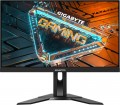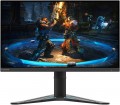Surface treatment
Modern monitors can use displays with both glossy and matte screen surfaces.
A matte surface is in some cases more preferable due to the fact that on a
glossy screen, when exposed to bright light, noticeable glare appears, sometimes interfering with viewing. On the other hand, glossy screens offer better picture quality, higher brightness, and richer colours.
Due to the development of technology,
monitors with a special anti-glare coating have appeared on the market, which, while maintaining all the advantages of a glossy screen, creates significantly less visible glare in bright ambient light.
Pixel size
The size of one dot (pixel) on a monitor screen. This parameter is related to the maximum resolution of the monitor and its diagonal size — the higher the resolution, the smaller the pixel size (with the same diagonal) and vice versa, the larger the diagonal, the larger the size of one pixel (with the same resolution). The smaller the size of one pixel, the clearer the image will be displayed by the monitor, the less grainy it will be noticeable, which is especially important on large monitors. On the other hand, a small pixel size creates discomfort when working with fine details and text — this mainly applies to monitors with a small diagonal.
Response time (GtG)
The time each individual pixel on the monitor takes to switch from one state to another. The
lower the response time, the faster the matrix responds to the control signal, resulting in less delay and better image quality in dynamic scenes.
Note that in this case, the gray-to-gray method is used (the time it takes to switch from 10% gray to 90% gray). Pay attention to this parameter if the monitor is specifically purchased for fast-paced games, movie watching, or other applications involving quick screen movements. However, there’s no need to chase the fastest models. It’s not often possible to discern the difference between
1 ms and
5 ms. For most scenarios,
monitors with a 4 ms response time will suffice. In any case, it’s best to rely on live impressions for a true comparison.
Brightness
The maximum brightness provided by the monitor screen.
Choosing
a monitor with high brightness is especially important if the device is going to be used in bright ambient light — for example, if the workplace is exposed to sunlight. A dim image can be "dampened" by such lighting, making work uncomfortable. In other conditions, the high brightness of the screen is very tiring for the eyes.
Most modern monitors give out about 200 – 400 cd / m2 — this is usually quite enough even in the sun. However, there are also higher values: for example, in LCD panels (see "Type") the brightness can reach several thousand cd/m2. This is necessary taking into account the specifics of such devices — the image must be clearly visible from a long distance.
Static contrast
Static contrast provided by the monitor screen.
This value describes the difference between the brightest whites and darkest blacks that the screen is capable of producing. In this case, unlike dynamic contrast (see below), the difference is indicated on the condition that the brightness of the screen backlight remains unchanged. In other words, this is the contrast that is guaranteed to be achievable within one frame. Static contrast is inevitably lower than dynamic. However, it is she who describes the basic capabilities of the screen.
The minimum static contrast ratio for tolerable image quality is considered to be 250:1, but even the most modest modern monitors give out about 400:1 (and a value of
1000:1 is not the highest class), and in high-end models this figure can reach 2000:1 and even more. .
Dynamic Contrast
Dynamic contrast provided by the monitor screen.
Dynamic contrast refers to the difference between the brightest white at maximum backlight intensity and the deepest black at minimum backlight. In this way, this indicator differs from static contrast, which is indicated with a constant backlight level (see above). Dynamic contrast ratio can be expressed in very impressive numbers (in some models — more than 100,000,000: 1). However, in fact, these figures are poorly correlated with what the viewer sees: it is almost impossible to achieve such a difference within one frame. Therefore, dynamic contrast is most often more of an advertising than a practically significant indicator, it is often indicated precisely in order to impress an inexperienced buyer. At the same time, we note that there are "smart" backlight technologies that allow you to change its brightness in certain areas of the screen and achieve a higher contrast in one frame than the claimed static one; these technologies are found mostly in premium monitors.
Colour space (sRGB)
Monitor colour gamut Rec. 709 or sRGB.
Any colour gamut is indicated as a percentage, however, not relative to the entire variety of visible colours, but relative to the conditional colour space (colour model). This is due to the fact that no modern screen is able to display all the colours visible to humans. However, the larger the colour gamut, the wider the monitor's capabilities, the better its colour reproduction.
Nowadays, sRGB is actually the standard color model adopted for computer technology; This is what is used in the development and production of most video cards. For television, the Rec. standard, similar in parameters, is used. 709. In terms of the range of colors, these models are identical, and the percentage of coverage for them is the same. In the most advanced monitors it can
reach or even exceed 100%; These are the values that are considered necessary for high-end screens, incl. professional.
Colour space (DCI P3)
Colour gamut of the monitor according to the DCI P3 colour model.
Any colour gamut is indicated as a percentage, however, not relative to the entire variety of visible colours, but relative to the conditional colour space (colour model). This is due to the fact that no modern screen is able to display all the colours visible to humans. However, the larger the colour gamut, the wider the monitor's capabilities, the better its colour reproduction.
DCI P3 is a professional colour model used primarily in digital cinemas. It is noticeably more extensive than the standard sRGB, which gives better and more accurate colours. Accordingly, the percentage values are smaller — for example, 115% of sRGB coverage corresponds to approximately 90% of DCI P3 coverage; in the most advanced modern monitors, coverage according to this standard is
98 – 100%. At the same time, DCI-P3 support is not cheap, and therefore it is found mainly in high-end monitors for professional and gaming purposes.
TÜV Rheinland certificate
Display certification for safe blue light emissions and panel flicker. The presence of a certificate confirms the comfort of the screen for the eyes.
TÜV Rheinland is a large international concern headquartered in Cologne, Germany, providing a wide range of audit services. The company's specialists have developed and approved a number of tests for the compliance of the screens of mobile devices, monitors and TVs with the required level of eye protection from the harmful effects of display radiation on the user's vision on the other side of the screen. The authoritative opinion of TÜV Rheinland is respected in the tech community. Certificates from this body are issued to successfully tested electronics for the implementation of blue light filtering and screen flicker suppression technologies.

